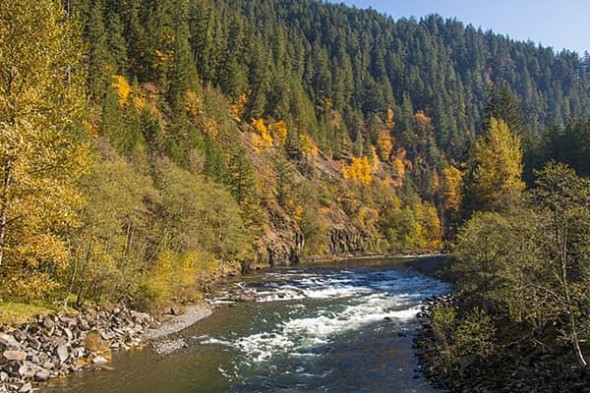Where Our Power Comes From: the Clackamas River
Posted on January 29, 2021 by Will Gehrke
Tags, Energy

Where does our power come from? Here at CUB, much of our work is predicated on the belief that shedding light on this question for utility customers is good for their consumer interests. Most readers are probably aware that a large percentage of power generated in the Pacific Northwest and here in Oregon is hydroelectric. But some may be surprised to learn how much of Oregon’s hydro power comes from the Clackamas River.
In the early 20th century, hydroelectric dams were the primary power source in the Northwest. In order to economically electrify the Portland region, Portland General Electric (PGE) constructed four dams: the Faraday, River Mill, Oak Grove, and North Fork dams on the Clackamas River. Today, due to the age of these facilities, customers have largely paid off their construction cost. Unlike a natural gas plant or a coal power plant, hydroelectric plants are powered using running water which does not have a fuel cost. For these reasons, the Clackamas River dams are the oldest and some of the cheapest sources of power for customers of PGE.
The Clackamas River is an 83-mile tributary of the Willamette River that originates as an offshoot of the Columbia. The Clackamas is an important economic artery for the Portland Metropolitan Area. It provides drinking water to nearly 200,000 Oregonians, including the cities of Lake Oswego, Tigard, and Estacada. The Clackamas watershed region cuts through the Mount Hood National Forest and is a major recreation site, popular for boating, fishing, and hiking.
Like other hydroelectric projects, the Clackamas River dams are renewable, zero carbon, and local resources that draw energy from the water cycle. The annual hydrologic cycle begins with seasonal rain and runoff from the snowpack. The runoff collects in lakes, brooks, and streams until it reaches the Clackamas River. The Clackamas’s water is funneled by PGE’s dams into a hydroelectric powerhouse, which turns a large wheel called a turbine. This spinning turbine rotates magnets past metal coils to generate electricity, which is then carried to customers on transmission lines. The Clackamas hydroelectric projects experience seasonal generation, which ramps up during the spring runoff. Combined, they generate enough energy to power 78,000 homes.
The federal government requires PGE to have a hydropower license to operate hydroelectric dams. When a new dam is constructed, hydroelectric operators are granted a term-limited license, usually fifty years. When an operator’s license expires, the operator must petition to relicense the facility. The Federal Energy Regulatory Commission (FERC) oversees the relicensing process and must weigh the economic benefit of the hydro power against environmental and local concerns.
A major environmental concern with hydro power is fish passage. The Clackamas River is home to cutthroat trout and coho salmon, including both seasonally migrating and year-round populations. Dams represent an obstacle to fish spawning in the river - however, PGE operates fish passage equipment that allows the fish to bypass the dams. In the relicensing process, the fish passage equipment is evaluated by stakeholders and FERC. PGE as a hydroelectric license holder is also required to maintain safe public recreation access to the river. In order meet this requirement, PGE operates several parks in the Clackamas River region.
Last year’s historic late summer wildfires swept through the Clackamas River region, destroying residences, business and other structures, and transmission lines. Oregon Highway 224, which runs parallel to the Clackamas near Estacada, has been shut down since the wildfire. To restore power flowing from the Clackamas River dams to PGE’s customers, PGE will have to rebuild the transmission system around the dams. In future blog posts, CUB will detail PGE, Pacific Power, Avista, and NW Natural rate requests related to the 2020 wildfires in Oregon.
To keep up with CUB, like us on Facebook and follow us on Twitter!





01/29/21 | 0 Comments | Where Our Power Comes From: the Clackamas River